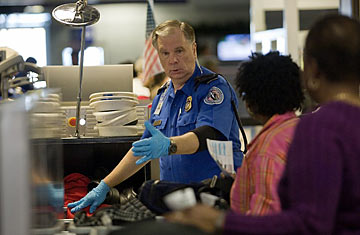
Almost immediately after a Nigerian man allegedly tried to annihilate Northwest Flight 253 on Christmas Day, aviation officials let fly a slew of ferocious new security regulations. Passengers were submitted to pat-downs and luggage searches, said goodbye to their in-flight Internet access and forfeited the ability to move about the cabin or rest pillows, blankets or personal belongings in their laps for the last hour aloft, among other inconveniences. But the crackdown was short-lived; by Sunday, Dec. 27, the rules had reportedly been eased, and on Dec. 30, less than a week after they were implemented, they are set to expire altogether. Should passengers be worried?
Probably not — because experts doubt the measures did much to boost safety in the first place. "You can imagine someone whispering into the ear of an official at Homeland Security and saying, 'If we don't do something and there's another attack, then we're going to get hammered," says Jim Walsh, a research associate in the Security Studies Program at MIT. "That logic has a certain appeal to it if you're trying to protect the reputation of the organization you're employed by, but it doesn't do much for the traveling public."
Case in point: the rule that all passengers must be frisked. The alleged attacker, Umar Farouk Abdulmutallab, 23, reportedly hid the explosives in his underwear — but passengers have reported that security officers who patted them down never went near their skivvies. "My guess is, if they were doing the truly intrusive pat-down designed to find even three ounces of explosives," says Stewart Baker, former assistant secretary for policy at the U.S. Department of Homeland Security, "we probably would have heard cries of protest from travelers." The lack of furor suggests the pat-downs were probably annoying and not much else.
Likewise, requiring passengers to remain seated for the last hour of the flight has little apparent safety value. "I've discussed that with many people within the aviation-security field. Nobody for the life of them can figure out what that would accomplish," says Douglas Laird, president of the international aviation-security consulting firm Laird & Associates and former security director for Northwest Airlines. A lengthy transatlantic flight would provide ample opportunity to set up and detonate an explosive device; limiting passengers' movements in the final 60 minutes, Laird says, is "just a symbolic gesture."
Experts say that more aggressive safety protocols might have uncovered Abdulmutallab's alleged plot before he had the chance to botch it with a bum detonator. Full-body scanners might do the trick, but they have their drawbacks. The ACLU has condemned backscatter X-ray and millimeter-wave-radar scans as the high-tech equivalents of strip searches. Furthermore, "every technology can be defeated one way or the other," says Vahid Motevalli, who studies aviation security at Purdue University.
A solution, Motevalli says, is to use better intelligence to root out would-be attackers before they strike, instead of just detectors and deterrents. But safety also hinges on encouraging if-you-see-something-say-something vigilance on the part of passengers. And on that score, the overzealous regulations might have been just the ticket. "It's a knee-jerk reaction to get public attention, perhaps. And that's quite a good thing," says Ken Button, director of George Mason University's Center for Transportation, Policy, Operations and Logistics. Ultimately, he notes, it was the intervention of fellow passengers, along with a faulty trigger device, that brought Abdulmutallab down. "We do have to some extent [to] rely on individuals," says Button. "They should be reminded of this."
